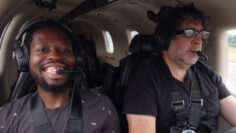Decoding the Meaning of “Heavy” in Aviation

In the dynamic world of aviation, particular terminology holds significant meaning and plays a crucial role in aircraft classification and operations. One such term is “heavy.” This article will explore the meaning and significance of “heavy” in aviation, shedding light on its implications for airports, air traffic control, and standardized communication. By understanding the nuances of this term, we can gain a deeper appreciation for the intricacies of aviation terminology and its impact on the industry as a whole.
Understanding “Heavy” in Aviation


To decode the meaning of “heavy” in aviation, we must start by defining the term itself. In aviation, “heavy” is a designation given to specific aircraft based on a special criterion. Generally, an aerial vehicle is classified as “heavy” if it exceeds a certain weight threshold, typically set by aviation authorities. However, the specific weight threshold can vary between countries and regulatory bodies.
Several factors contribute to an aircraft’s designation as “heavy.” These factors include:
-
Maximum takeoff weight:
This refers to the maximum weight an aircraft can take off at, including its weight, passengers, cargo, and fuel.
-
Wingspan:
The wingspan is the distance between the tips of an aircraft’s wings when fully extended.
-
Approach speeds:
These are the speeds at which an aircraft approaches the runway during landing.
By considering these variables, aviation authorities can categorize aircraft into different classes, such as light, medium, and heavy. This classification system helps with:
- Managing air traffic: By categorizing aircraft based on size and weight, air traffic control can efficiently allocate airspace and ensure safe separation between different aircraft types.
- Determining runway requirements: Heavy aircraft require longer runways for takeoff and landing due to increased weight and higher approach speeds. Proper runway planning and allocation are essential for heavy aircraft safe operation.
- Facilitating efficient ground operations: Ground handling procedures, such as fueling, cargo loading, and aircraft towing, need to be tailored to the size and weight of heavy aircraft. By classifying them separately, ground crews can prepare the necessary equipment and resources to handle these operations effectively.
Significance and Implications of “Heavy”

The classification of an aircraft as “heavy” has significant implications for airport operations and air traffic control. Consider the following aspects:
- Runway Capacity:
Heavy aircraft require longer runways for takeoff and landing, affecting runway capacity and influencing the scheduling and sequencing of flights. These aircraft need adequate runway length to achieve the necessary lift and braking distance, ensuring safe operations.
- Separation Requirements:
Stricter separation requirements exist between heavy aircraft and other traffic to ensure safety. Due to their size, weight, and wake turbulence, heavy aircraft need more distance between them and smaller aircraft to prevent potential hazards.
- Ground Handling:
Heavy aircraft necessitate specialized ground handling procedures involving larger fuel trucks, cargo loaders, and towing vehicles. Ground crews receive specific training to handle heavy aircraft safely and efficiently. They must consider weight distribution, balance, and center of gravity when loading cargo and fueling the aerial vehicle.
- Safety Considerations:
Pilots of heavy aircraft undergo specialized training to handle the unique characteristics of these aircraft, ensuring safe operations and mitigating potential risks associated with their size and weight. They get trained to account for longer takeoff and landing distances, increased fuel consumption, and limitations during adverse weather conditions. Additionally, maintenance and inspection requirements for heavy aircraft are often more stringent to ensure their continued airworthiness and safe operation.
Standardized Communication and “Heavy”

Standardized communication is critical in aviation, enabling efficient exchanges between pilots and air traffic controllers. Using specific terminology, such as “heavy,” is an aspect of this standardized communication. When pilots identify as “heavy” during radio communications, it informs the air traffic controllers about the size, weight, and performance characteristics. This approach allows controllers to:
- Manage airspace. Air traffic controllers can allocate appropriate airspace to accommodate the aircraft’s size and performance capabilities, ensuring safe and efficient routing.
- Assign appropriate runways: By knowing that an aircraft is “heavy,” controllers can assign suitable runways that accommodate the aircraft’s length and weight requirements.
- Coordinate arrivals and departures effectively: The “heavy” designation helps controllers to sequence & manage the flow of heavy aircraft, considering their specific performance characteristics and potential wake turbulence effects.
For more information on radio communications phraseology and techniques in aviation, you can refer to the ‘Radio Communications Phraseology and Techniques’ section on the FAA’s official website. This resource provides valuable guidelines and standards for effective communication between pilots and air traffic controllers.
Common Questions about “Heavy” in Aviation

Let’s have a look at some of the frequently asked questions:
What factors contribute to a “heavy” aircraft?
The classification of an aircraft as “heavy” is typically based on its weight and other factors like wingspan and approach speeds. Specific weight thresholds may vary between regulatory bodies.
Are there other aircraft classifications besides “heavy”?
Yes. Besides “heavy,” aircraft are also classified as light, medium, and super. These classifications help in managing air traffic and determining operational requirements. Each terminology has its own set of criteria and implications.
How does the “heavy” designation impact air traffic control procedures?
The “heavy” designation influences air traffic control procedures in assigning appropriate runways, managing airspace, and coordinating aircraft movements to ensure safe and efficient operations. It helps controllers make informed decisions based on the aircraft’s size, weight, and performance characteristics.

In summary, “heavy” in aviation operations have an imperative meaning. By understanding its definition, significance, and implications, we gain insights into how this term affects airport operations, air traffic control, and standardized communication. The appropriate understanding and use of “heavy” as a standardized term facilitate safe and efficient aviation operations, enabling clear communication between pilots and air traffic controllers. As aviation continues to evolve, maintaining standardized terminology and adhering to established protocols will remain essential to ensure the safety and effectiveness of the industry overall.
We encourage you to actively engage with us by sharing your thoughts and insights in the comments section below.
If you found this article informative and thought-provoking, we invite you to share it with your friends, colleagues, and fellow aviation enthusiasts. Spread the knowledge and generate meaningful discussions around aviation terminology and its impact on the industry.
In addition, don’t miss out on our recent article – “The Future of Flying Taxis: Unlocking Urban Mobility.” This exciting piece explores the transformative potential of flying taxis in revolutionizing urban transportation.






